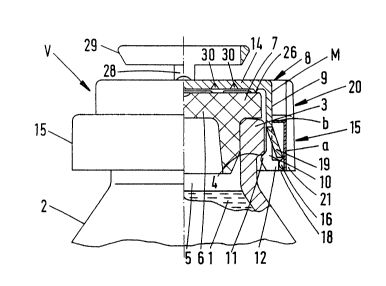Note: Descriptions are shown in the official language in which they were submitted.
~0~55~.
CLOSURE CAP FOR INFUSION OR TRANSFUSION BOTTLES
The present invention relates to a closure cap for
infusion or transfusion bottles.
A closure cap of this type is known, for instance, from
Federal Republic of Germany Patent 37 15 175. In that case,
the stopper is secured by the conventional flanged cap. An
opening left in the top of the flanged cap permits access of
a cannula or the transfusion fitting. In its original state
this opening is kept closed by means of a plastic lid which
at the same time forms a germ-proof barrier. The lid can be
torn off when desired. Score lines produced by a weakening
of the thickness of the material of the plastic lid
facilitate this.
From US Patent 4 520 942 it is known to transversely
divide a metal cap surrounding a plastic lid in order to
obtain access. For this purpose, the metal cap has
diametrically extending predetermined tear lines which define
a transverse tab. The free ends of the portion delimiting
the transverse tab are continued at both ends into a
peripheral, free-standing pull tab.
From US Patent 3 698 584 it is furthermore known to
provide a screw cover of a container with an axially
displaceable annular collar which on its inner side has
ledges which lock the rotation of the screw cap and cooperate
with mating locking means on the neck of the container. This
development provides security against children.
The object of the present invention is to improve, by
structurally simple means, the customary flanging of the
stopper covering while retaining the customary firmness of
attachment.
204~55J.
As a result of the invention, there is created a closure
cap of this type which satisfies the basic requirement of a
antiseptic seal as well as that of an attachment which
remains stable in use, but with which the flanging, which
requires special devices, is dispensed with. Mounting can be
effected by simply placing the parts one on the other.
Nevertheless, the number of parts is not increased.
Specifically, according to the invention the underyripping on
the part of the cap is obtained by resilient individual
tongues which are held in the undergripping position by
pressing by a displaceable ring which surrounds them, the
pressing means serving at the same time to secure the sliding
ring in its pressing position in the manner that the
supporting means on their part grip below locking tongues on
the cap. The sliding ring, which advantageously acts as
pressing hoop, can be moved into its active locking position
with relatively little force; it can be pulled off only with
recognizable damage to the parts which produce the detent
engagement obtained; any tampering with the original closure
is clearly recognizable. From a structural standpoint and
also for a balanced loading of the parts providing the detent
connection, it has proven advisable for the individual
tongues and the locking tongues to be provided in alternate
sequence on the periphery of the cap. The cap may advisedly
be of a construction of rotational symmetry, although other
cross-sectional shapes of a non-circular type would also be
conceivable. From the standpoint of stability, it is
furthermore advantageous for the sliding ring to have an
angular profile in cross section and for the arm of the angle
which is directed radially inward to the stopper to extend on
the outer surface of the cap in the region above the roots of
Z